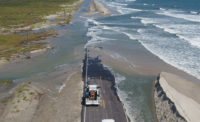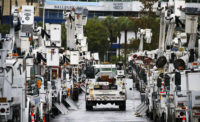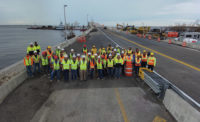Tyndall Air Force base in northern Florida is a hive of construction activity five years after its devastation from Hurricane Michael when the Category 5 storm swept ashore on Oct. 10, 2018—destroying nearly every structure at the facility.
“The decision was made very quickly and the storm only gave us one option … to rebuild from scratch,” says Col. Robert Bartlow, chief of the Air Force Civil Engineer Natural Disaster Recovery Division, based at the base, which is located 12 miles west of Panama City in Florida’s panhandle.
Four years of planning followed, with the first new building, a simulator facility, completed in August 2022. Four or five more have recently finished or will wrap up in the next several months, says Bartlow. By the sixth anniversary of Hurricane Michael's landfall, a little more than half the program will be done, with full completion set for mid-2025 or early 2026.
The monumental, $5-billion effort will transform the base into what the U.S. Air Force terms “the installation of the future”—buttressed against damaging hurricanes in the Gulf of Mexico with updated and enhanced building requirements and an all-of-the-above approach to resilience that includes nature-based solutions.
“When everything’s done, I anticipate Tyndall being a highly sought-after assignment based on the quality of the facilities and the people,” Bartlow says.
When Michael made landfall near Tyndall, it brought a storm surge of 9-14 ft and winds of 140-161 mph, according to the National Weather Service, causing catastrophic damage from Panama City Beach to Mexico Beach and Cape San Blas.
Tyndall experienced sustained winds of 155 mph from Michael, which was the strongest sustained wind-speed hurricane to hit the continental U.S. in more than 25 years, according to the Weather Service. Before the storm, more than 11,000 people were evacuated with just 93 remaining on-base.
“The pictures don’t do it justice,” says Bartlow. “Any [buildings] left standing had such significant damage that for the most part they weren’t usable.”
Arriving at Tyndall about three weeks after the storm, he says the damage made him recall images of deployments to Iraq in the early 2000s, working at airfields essentially destroyed early in the war.
“It felt and looked a lot like that,” he says. “As an engineer, it was overwhelming.”
When then-Air Force Secretary Heather Wilson visited the base, Bartlow recalls her saying not to build back what was there, but to “build back the base that we need going into the future,” focused on resilience after the unprecedented storm.
Every facility on the almost 30,000-acre base suffered damage to some degree, from either winds, storm surge or heavy rainfall, rendering them all unsalvageable from an economic standpoint. After demolition of 276 buildings, work at Tyndall turned to Installation of the future— planning more than 3 million sq ft of construction in 144 buildings for the rebuilding program.
Today, around 95% of that program is under construction, up from about 30% one year ago, Bartlow says. All facilities being constructed will be designed to withstand wind speeds of at least 165 mph, raised to elevations to withstand storm surges for the next 75 to 100 years and constructed with low-maintenance materials, he says.
 With sustaining winds of 155 mph, Hurricane Michael made landfall on Oct. 10, 2018 at Tyndall Air Force Base near Panama City, Fla., with damage to all of its buildings, none of which was salvageable. Photo courtesy NOAA
With sustaining winds of 155 mph, Hurricane Michael made landfall on Oct. 10, 2018 at Tyndall Air Force Base near Panama City, Fla., with damage to all of its buildings, none of which was salvageable. Photo courtesy NOAABreaking Ground
Currently, 40 construction projects are underway, spanning a dozen construction zones and totaling roughly $3.1 billion in contracts, says Don Arias, Air Force spokesperson. Adding in other projects, including facilities, sustainment, restoration and modernization, as well as operations and maintenance funding, the total comes to about $5.1 billion.
Among those contracts is a $532-million award to Hensel Phelps in May 2022 for 11 facilities, including three aircraft hangars, flight simulator facility, squadron maintenance complex and group headquarters building.
A Pacwest-Korte Joint Venture is constructing the base’s sports complex and pool facility, a $38.2-million project with outdoor pool and splash park, bath house, playground, four ballfields and recreational support building as well as utilities, site improvements and other supporting work.
Gate complexes designed to withstand 165-mph winds, including gatehouses, lane houses, overwatch positions, active barrier systems and canopies, are being constructed by B.L. Harbert International, which was awarded the $42.8-million contract in May 2022.
EMR Inc. was awarded a $22.1-million contract for the CE maintenance shop and storage area, including three separate structures of 9,800, 10,300 and 5,900 sq ft.
Dothan, Ala.-based Barlovento, LLC is constructing the $6.3-million, 10,000-sq-ft Security Forces Mobility Storage Facility, which will be built to withstand 170-mph winds and serve as a deployment and hurricane preparation area as well as equipment and vehicle storage site alongside overflow and office space.
Other contractors working on-base include Lane, Green-Simmons Co., Howard Pence, Caddell, 4K Global, Roundhouse, Healtheon, Haskell and a Southeast Industrial Construction-Barlovento joint venture.
Building Back Better
According to the Air Force, the rebuild effort exceeds baseline standards for the U.S. Dept. of Defense and Unified Facilities Criteria to specifically address Tyndall’s horizontal and vertical construction requirements, a strategy to provide “guardrails” for the rebuild effort without inhibiting site innovation and creativity.
Performance standards for new structures at Tyndall define risk categories for buildings from 165- to 203-mph winds, and sets the design flood elevation at 19 ft above mean sea level for the Gulf side of the base and 14 ft above sea level for the East Bay side.
Exterior architectural envelope elements are required to be impact-resistant and meet Miami-Dade County Product of Approval Notice of Acceptance provisions to reduce risk of envelope failure and building loss. Exterior site furnishings and light poles are designed to withstand 170 mph winds. Primary utility distribution systems will be placed underground and motor-operated distribution switching will be installed to minimize disruptions, as will backup generators to serve mission critical buildings.
In its infrastructure, the base will integrate long-life pavement design and maximize recycled asphalt and concrete in construction of a Multi Modal Spine to accommodate various modes of transport.
Air Force crews used climate modeling in conjunction with Dept. of Defense climactic models to forecast effects of a Category 5 storm surge, and planned building elevations accordingly, Bartlow says. Any buildings that could be elevated were essentially designed to flood, he explains, so that after the storm, they can be quickly cleaned out and put back into operation.
Innovation and use of the latest technology is also part of the construction process, including piloting applications for 3D-printed concrete, with a demonstration facility constructed by Austin, Texas builder Icon.
 Personnel returned to Tyndall following Hurricane Michael to find a scene that base official Col. Robert Bartlow compared to war-torn airfields in Iraq in the early 2000s. Photo courtesy WSP USA
Personnel returned to Tyndall following Hurricane Michael to find a scene that base official Col. Robert Bartlow compared to war-torn airfields in Iraq in the early 2000s. Photo courtesy WSP USADigital twin technology was implemented early on, a capability Bartlow says was quickly adopted, with a digital twin of the base nearly complete. Teams will then move into the next phase—handing work over to engineers responsible for maintaining the installation. That’s not an end in itself, he points out, but a foundation to host other applications to allow engineers to visualize and troubleshoot going forward.
Self-Monitoring Analysis and Reporting Technology (SMART) building technologies will collect, display, record, analyze and disseminate information, providing monitored utility subsystems using an array of commercially available software suites integrated into a single platform. That data, used for access control, building envelope, HVAC, power and plumbing will enable the base to support faster and better decisionmaking, save operational costs and energy, enhance safety and extend the life of facilities.
A little more than a year after Michael, Tyndall also was hit with another disaster: the COVID-19 pandemic. The biggest impact early on was limited travel during the project’s design and planning phase, Bartlow says, leading to some details missed or overlooked. More recently, as with the rest of the industry, supply chain issues, inflation and scarcity of materials and workers have also been obstacles to overcome.
There have been some delays in construction and cost increases as the Air Force navigates those issues, which Bartlow compared to a game of Whack-a-Mole.
The First (Coast) Line of Defense
“The coastline is the first line of defense, and failure to bolster that coastline would be doing the rebuild a disservice, because we would not be investing in infrastructure to protect the investments we have made,” says Garey Payne, Air Force base acquisition program manager.
The DOD identified climate change as a threat to its operations and installations in 2010, and included in Tyndall's rebuild are nature-based pilot projects aimed to slow storms as they approach the base.
Luce Bassetti, Americas coastal resilience director at Jacobs, began working in 2019 on a coastal resilience implementation plan to quantify present and future risks at Tyndall—presenting a hybrid approach with nature-based coastal solutions as one of multiple lines of defense to make the base more resilient against future natural disasters in a way that lives up to the moniker Installation of the Future.
 Coastal resilience strategies at Tyndall Air Force Base include oyster reefs, restored dunes, seagrass plantings and marsh restoration. Image courtesy Jacobs
Coastal resilience strategies at Tyndall Air Force Base include oyster reefs, restored dunes, seagrass plantings and marsh restoration. Image courtesy Jacobs The objective of the plan is to preserve base operating capabilities and enhance the natural and structural flood protection system to deliver more than operational resilience, she says, but also provide social and environmental benefits.
“The bottom line is that coastal resilience is not just about the coast, it’s about everything,” Bassetti says. “It’s about roads, it’s about stormwater, it’s about the energy.”
Coastal resilience is a nationwide challenge, she says, felt most acutely along the coasts where installations and businesses need to develop resilience to a broader, emerging range of interconnected threats and hazards; it’s a problem with no “one-size-fits-all” solution.
“Critical infrastructure, including energy, water and transportation systems, are increasingly affected by hazards such as storms, flooding and slow-onset changes, including sea level rise,” says Bassetti, who found her passion for protecting oceans and coastlines growing up in coastal France.
To accomplish the coastal restoration pilot projects, Tyndall is partnering with environmental nonprofit The Nature Conservancy, which describes the base as not only an invaluable military installation but also an ecological treasure—with Its areas of longleaf pine, beach dunes, grasslands, wetlands and brackish estuaries serving as biodiverse habitats for everything from woodpeckers to terrapins, and oysters to crabs.
Through a $4.8-million DOD grant, the group is currently working on four projects: a 1,500-ft living shoreline, submerged shoreline, seagrass planting and 1,000-ft oyster reef breakwater.
“The projects we’re doing are not just focusing on hurricane mitigation,” says Payne, but also "on every-day, day-to-day mitigation of wave energy, whether tidal, wind-driven or hurricane.”
One pilot project includes an oyster reef, reinforcing large dunes on the southern edge of the base, and making intertidal or subtidal improvements to reduce erosion that would also increase habitat for threatened and endangered species.
Others include rebuilding dunes on barrier islands through trapping wind-blown sand with alternative methods like sand fences, woody debris and new plantings, as well as feasibility studies for the strategic placement of subtidal sediments. Modeling would be used to identify places where waves and tides would carry sediment shoreward to enhance beaches and marshes to help buffer wave energy and contribute to lowering water levels at the base in a way that’s less expensive than conventional beach or marsh nourishment projects and avoid machine work in sensitive environments.
Rethinking Oyster Reefs
While Payne admits that oyster reefs, living shorelines and dune restoration are not innovative or new, they are an important part of Tyndall’s plans to withstand and quickly recover from the next big hurricane. Also, for the oyster reefs at least, it’s not the what, but the how that’s so innovative.
Tyndall and the Nature Conservancy are working with the Defense Advanced Research Projects Agency (DARPA), which is using a type of concrete developed at Rutgers University to create concrete forms offsite and install them, along with oysters to kickstart the new colony.
DARPA has partnered with Rutgers, the University of Miami and University of Hawaii for similar projects as part of its Reefense program, each testing different concrete mixes. Headed by program manager Catherine Campbell, it seeks to develop self-healing, hybrid, biological and engineered reef-mimicking structures to mitigate coastal flooding, erosion and storm damage.
At Tyndall, the project is still in the design phase, although each concrete unit of the reef will stand 4 ft tall with a width of one-half meter, Campbell says, as well as holes throughout for wave attenuation. They will be molded locally, and placed into position from a barge, designed to be produced by any traditional concrete manufacturer.
The Rutgers team, she says, is working on two different types of concrete for similar applications: one that’s biodegradable and designed to disappear as the natural oyster or coral reef forms, and another designed to sequester carbon by being cured in a carbon dioxide chamber.
“DARPA is here to prove out this concept that we can actually have these reefs that we can develop faster, that can attenuate wave energy and calm the shores behind,” says Campbell, noting that natural oyster reefs can take decades to form and coral reefs can take a century.
The first 50-meter oyster reef will be deployed in 2024, with the second 18 months later, she says. Reef performance will be monitored, with goals of reducing wave energy by 80% and protecting shorelines.
“The hope is if these are successful, they could be commercialized and adopted in any place that needs this coastal protection,” Campbell says, noting oysters will be used in temperate waters and corals in tropical ones.
Building a Blueprint
It’s not just oyster reefs that the project aims to make replicable. The entire program is is designed to eventually be exported to other Air Force installations, Bartlow says. He notes plenty of interest in resilient construction around the Gulf Coast, adding that officials are keeping track of construction and maintenance costs from projects that are designed to minimize them using new processes and materials.
Generally speaking, the program is transportable, says Payne, who has recently been in conversation with officials at MacDill Air Force Base near Tampa about building a more robust coastal resilience program there, as well as with Patrick Space Force Base in Brevard County, Fla., which reached out two years ago about the program given its experience with similar issues.
“Tyndall continues to identify innovations that we want to test on our installations, and [the base] will continue to bring forward those technologies, evaluate them and if they prove to have merit, disseminate them across the Air Force," says Bartlow.






Post a comment to this article
Report Abusive Comment